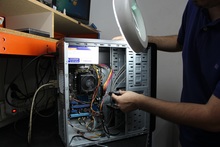Backing Up Your Data
What would happen if you suddenly lost all your CMMS data? What if you lost all your waiting work requests and work orders, plus all the information you've typed in about your equipment and inventory? How would you recover?
There are ways you can protect yourself (such as mirroring your disks), but the most important is making regular back-ups of all your date files. There are two ways to do this:
- Using MainBoss's own back-up facilities
- Using the back-up facilities built into Windows or in commercial back-up software
MainBoss Back-Up Facilities
The back-up facilities in MainBoss work through SQL Server. When you request a back-up (using Administration | Backups), MainBoss submits a request to SQL Server, asking it to take a back-up of the MainBoss database. (At the time you ask for a back-up, you specify where SQL Server should store the resulting back-up file; we strongly recommend that you do not use the default location, since this location is difficult to find and use.)
Once you've created the backup file, you should store a copy someplace safe. At the very least, the copy should be stored on a different disk; better than that is storing it on a different computer, and best of all is storing it in a completely different location from your usual MainBoss computer.
MainBoss Basic Back-Up Facilities
The back-up facilities built into MainBoss create a single ZIP file containing all your data. While creating such a back-up, MainBoss "locks" the database, preventing anyone from making changes to it. The benefit of this is that the back-up captures your database files in a "clean" state, as opposed to a situation where someone could be partway making changes to a file at the moment the file is being backed-up.
Once MainBoss has created the ZIP file, you have to store that file someplace safe. Don't store the ZIP file on the same disk that contains the original database—if that disk has a hardware failure or gets infected by a virus, the same problem may ruin the back-up.
Other Back-Up Facilities
The other way to back-up your files is to use the standard Windows back-up facilities or a commercial back-up software package.
To use the Windows back-up facilities, begin at the usual Windows Start button and select Programs->Accessories->System Tools->Backup. This opens a wizard that walks you through the back-up process.
With MainBoss, you can also use the back-up facilities provided by SQL Server. The free SQL Express version of SQL Server only supports manual back-ups; you have to tell the server when you want to do a back-up. Other versions of SQL Server let you set up schedules for automated back-ups.
Some commercial software packages are designed to collaborate with SQL Server when doing "full-system" back-ups. In this case, the commercial package backs up ordinary files directly, and calls on SQL Server to produce database back-ups.
Back-Up Considerations
Whichever way you back up your files, you should make sure the back-up is stored in a safe place. Storing it on another computer in your network is better than nothing, but it still runs a risk if a virus gets loose on the entire network or if your site gets hit by a serious problem (e.g. a fire or flood).
The best approach is to save your back-ups somewhere off site. For many organizations, a cheap practical solution is backing up your files to a data key, also called a USB flash drive. For under $100, you can buy a data key big enough to hold several copies of a typical MainBoss database. Back up your database to the data key every night, then take the key home with you. This is a very simple way to obtain off-site storage and protection.
Large organizations may have policies against taking home company data in this way. However, organizations of such size usually have an IT department that takes care of back-ups for you, including off-site storage.
Always keep a small set of independent back-ups. For example, if you make back-ups every night, don't overwrite yesterday's back-up with today's. Computer viruses can be sneaky: you might be infected without knowing it. When the virus finally starts causing problems, you may have to go back several days to find a back-up that's clean. You need to keep a backlog of separate back-ups so you can be confident that one of your back-ups is uninfected.
How often should you do back-ups? Every week? Every day? That depends on your work load. In small organizations, re-typing a week's worth of work may not be too bad; in large organizations, it might be a nightmare. Weigh the costs and come up with a solution you can live with...but one way or another, make sure you have back-ups.




